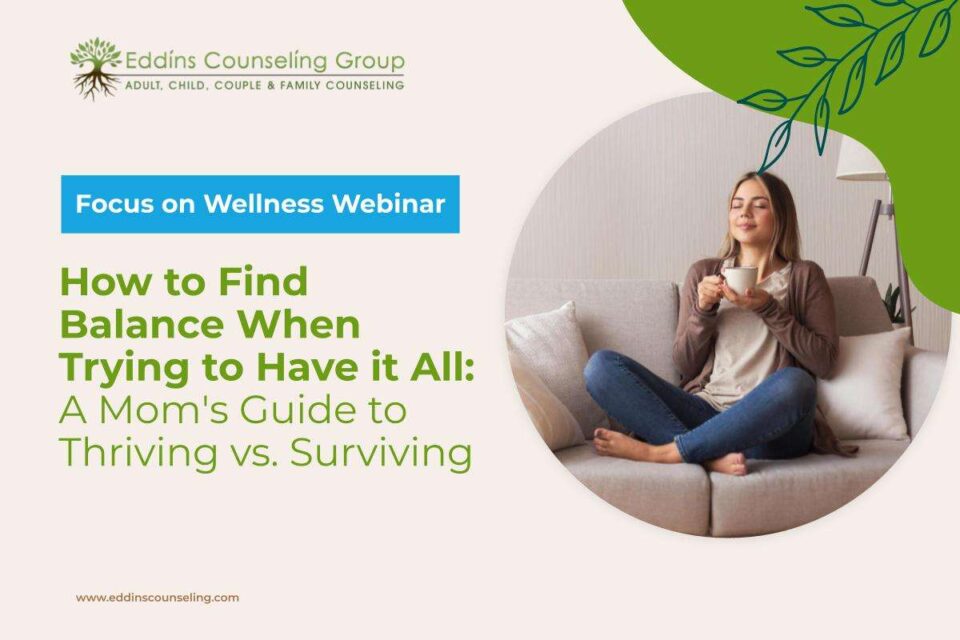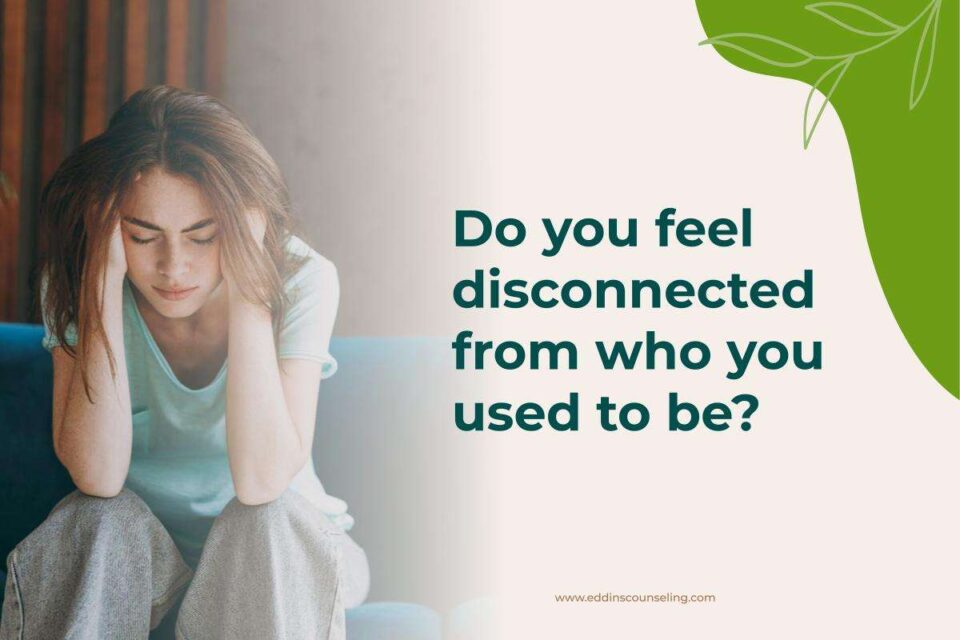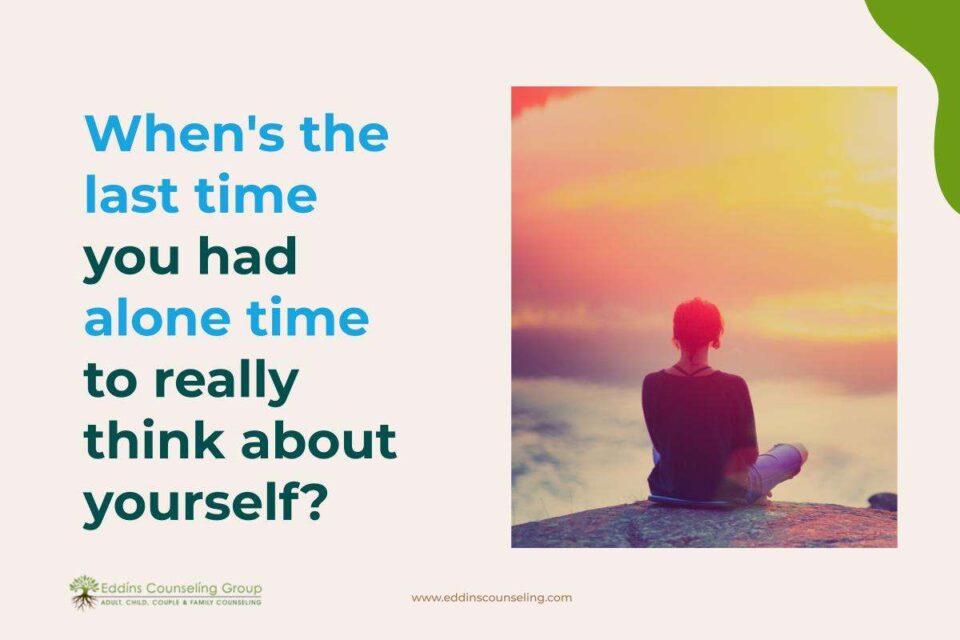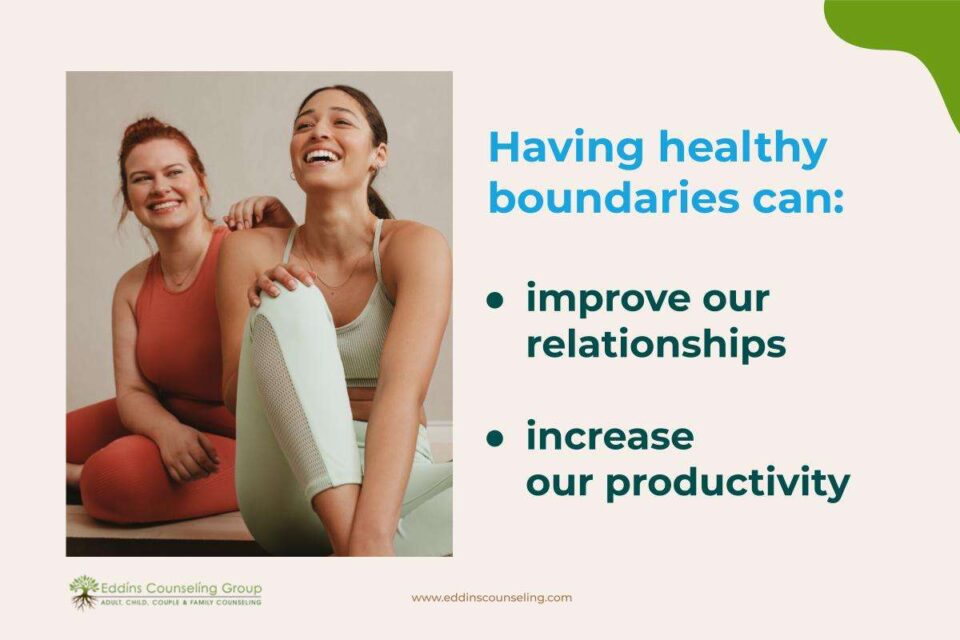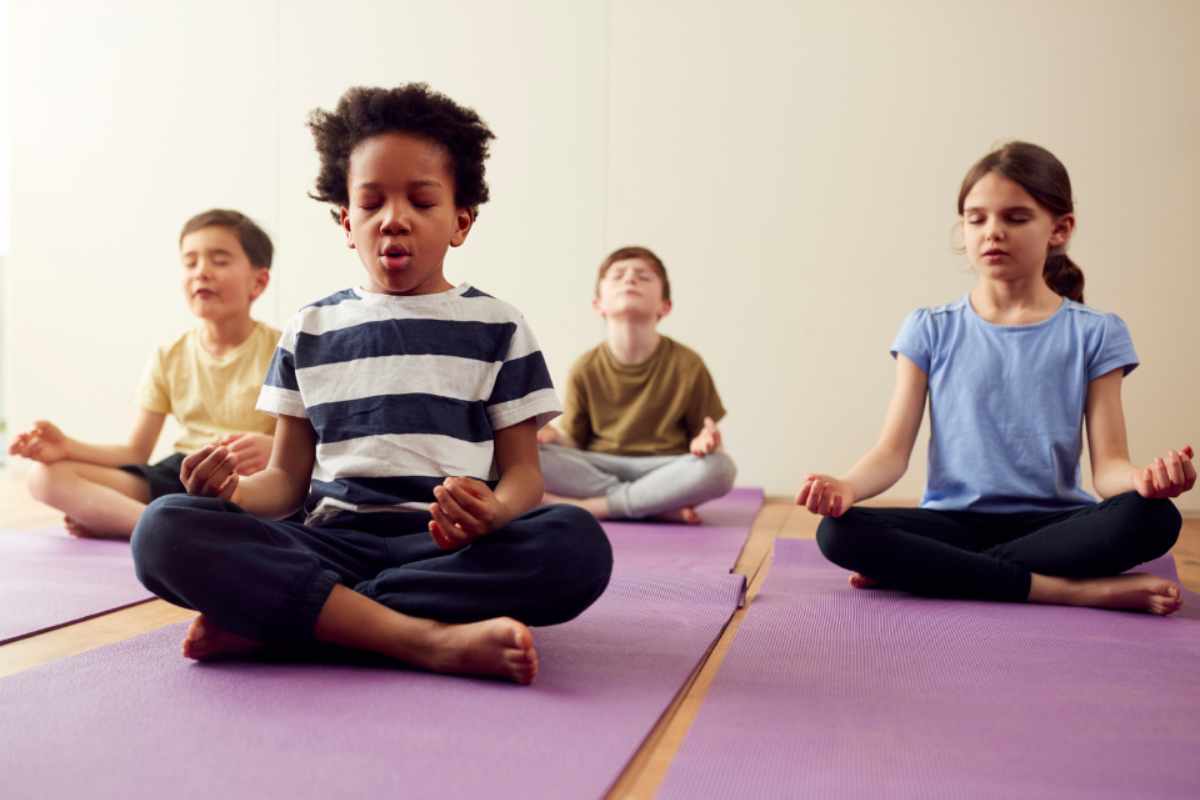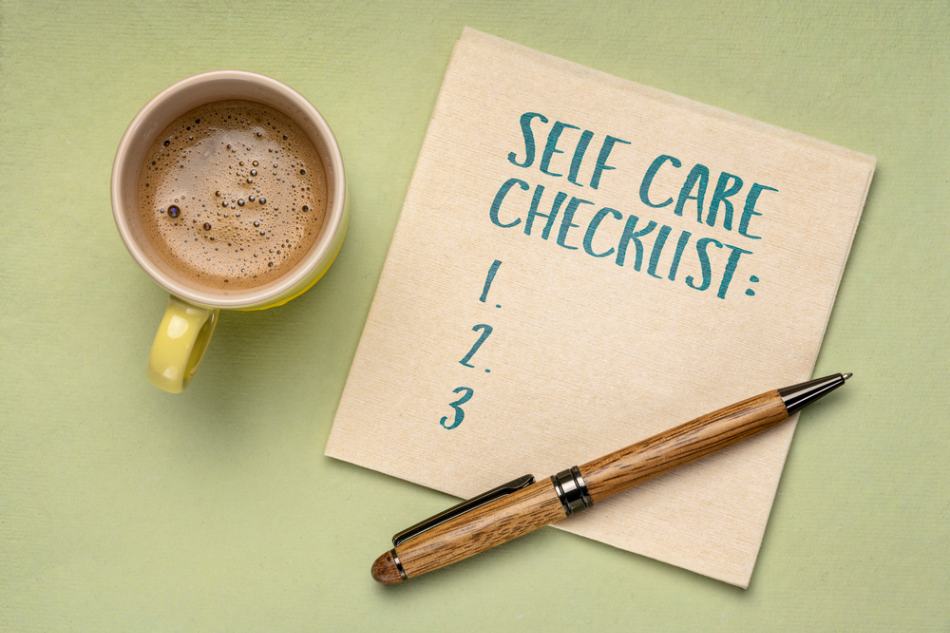October 8, 2020
Webinar: How to Find Balance When Trying to Have it All: A Mom’s Guide to Thriving vs. Surviving
Written by Rachel Eddins
Posted in Parenting & Family, Webinars and with tags: motherhood, parenting, women's issues

You are enough. You are doing your best.
- Are these messages you wish you could incorporate into your inner dialogue?
- Do you lie awake at night thinking you should have done more with your family or kids?
This workshop will help you re-frame your thinking about the time you have to give and become more present in the precious moments you have.
Facilitated by Diana Cabrera- Stewart.
Watch a replay of the presentation here.
Learn more about our Therapy for Women services.
Here is a transcript of the webinar:
Hello, my name is Diana Cabrera Stewart and I am a therapist at Eddins Counseling Group. This presentation is about Striving vs. Surviving as a Mom and Trying to Find Balance when we want it all (we want to be great parents, we want to be great in everything that we do, great employees, etc)
There will also be some interactive exercises and practices during this presentation. We’ll just use the chat box for that so you can interact with me. When people ask questions or make comments in the chat, I’ll read the question out and then respond.
Let’s get started. I also want to just remind you that there is a time in the end designated for questions.
So if you have any questions you want to ask, go ahead and shut them down, or you can even put them in the chat box and I’ll try my best to keep up with that. But there is a specific time set aside at the end for any questions.
A Little Bit About Me
All right, so a little bit about me. I have been with Eddins Counseling Group since November of 2019. I’ve been a therapist in the state of Texas. I’m a licensed professional counselor. I’ve been licensed since 2015 here, but I’ve been practicing since 2009.
I’m trained in EMDR and I have specific training in perinatal mental health for that period of time during pregnancy and the postpartum period.
In my work at a counseling group, I also do individual therapy and I do some groups in my area of emphasis is on working with Montrose, an area that is very near and dear to my heart. I understand the struggles firsthand.
Now, just kind of a little side note. I want to give credit where credit is due. A lot of the information in this presentation was gathered from “The Mother’s Guide to Self-Renewal” by Renee Trudeau.
Becoming A Mother
One of the things that are most difficult about becoming a mom is all of the changes that take place. Some we’re prepared for and some we’re not prepared for.
Some of us grew up in households or have friends and family who have become parents before us and have shared a lot of this information with us and some of us haven’t.
What Has Changed Since You Became A Mother?
- Physical
- Social
- Emotional
- Spiritual
Sometimes we’re surprised by some of these changes. But there are changes in all categories of our experience. We’ve got physical changes, social changes, and even emotional and spiritual changes for some of us.
What Has Changed in General?
- Appearance
- Fitness/Health
- Understanding of Self
- Relationship with Partner
- Family-of-Origin Relationships
- Friendships
- Emotions
- Work/Career
- Goals/Priorities
- Finances
- Availability of Time
This is probably stuff that you all are already familiar with, but just here are a few examples of some of the ways in which things change for us. For example, financially. We have other expenses we’re not used to having.
We suddenly find ourselves with not a whole lot of time available. We may be experiencing emotions that we’re not familiar with.
Our relationship with our partner might change.
A lot of these things don’t only change when we first become a mom. A lot of times they change with new stages of our children’s lives, new stages of our own life even.
These changes can occur over and over again for some people, or you might have some changes that come first and some will come later.
But I think there’s one thing we can be sure of in life, and that is that things are going to change.
Motherhood Changes Us In So Many Ways!
One of the ways that a lot of people find the experience change when they become parents or their children go through different stages of life or development, is that motherhood changes us in a lot of ways.
Our perceptions of ourselves can change. I don’t know if any of you have given that a whole lot of thought, but I’m just curious. I want to leave you with this question:
How has your perception of who you are changed since becoming a parent?
It may not be that you’ve changed. It may be that your perception of yourself has changed. And this is pretty normal to happen. Happens to many of us.
Challenges + Strategies
I want to talk a little bit about some of the challenges and then we’ll move into some strategies.
1) Common Challenges:
- I feel disconnected from who I used to be.
- I spend all my time taking care of everyone else and have nothing left for myself.
- I don’t have time for friends, or my friends don’t get me now that I’m a parent.
- I don’t have time for everything I need to do.
- Everyone is judging me (including myself)!
Some common challenge of motherhood is thinking: “I feel disconnected from who I used to be.” Maybe you remember who that person was, but you don’t feel like you can be her anymore.
Another very common challenge is: “I spend all of my time taking care of everyone else and there’s nothing left for myself.”
It can also be: “I don’t have any time for friends” or “Maybe my friends just don’t seem to get me anymore. My experiences as a parent have kind of created a little bit of a point where we don’t connect quite the same anymore.”
It might just be: “I don’t have time for everything that I need to do anymore”. And then one of the really common ones, especially for first-time parents, is this idea that everyone is judging you, including yourself.
There’s something that happens in the world of parenting where we suddenly realize that everyone thinks that they can have an opinion about how we raise our children or how our children behave in public. So we feel this judgment from others and we also judge ourselves. So that’s a really common challenge.
2) Strategies
- Intentional self-care
- Physical
- Emotional
- Spiritual
- Mental
- Personal support system
- Prioritize by honoring your values
- Manage your energy through appropriate boundaries
- Reframe unhelpful thinking
- Be present via mindfulness
These are the categories of strategies that we’re going to be talking about that. I’m going to be sharing them with you and we’ll be doing a little bit of practice in each area.
2.1 Intentional Self-Care
So, the first strategy is intentionally taking really good care of yourself. When we think about self-care, a lot of us have these “go-to” things that we think about. One of the stereotypical responses to that, and a very common one is: “I take a bubble bath or I get a massage or I get a pedicure.”
Things like that seem to be related to things that are related to grooming or really physically taking care of our nurturing our need for pampering. But physical is not the only area. We also have emotional self-care, spiritual self-care, and mental self-care. It’s important to pay attention to all of those areas.
2.2 Personal Support System
Having a really good support system is a strategy that can help us out a lot today. In a lot of communities, especially in a large city like this, people maybe have moved here for work or for some other reason than they’re separated geographically from their families of origin or from their friends they grew up with.
So it can take a lot more deliberate building of a support system in situations like that. Or maybe you live in the same town with your family, but they’re just not there for you in the way that you need, or they can only provide a little bit of support for you. So we’re going to talk a little bit about building a support system.
2.3 Prioritize By Honoring Your Values
Another strategy is really prioritizing by thinking about your values, what’s most important to you, and making sure that you’re deliberately setting those things into your life on a daily basis or a routine.
2.4 Manage Your Energy Through Appropriate Boundaries
We’re going to talk a little bit about managing your energy through setting appropriate boundaries and just really protecting your energy and not going for those energy training activities. Just select activities that fill you and you feel that you can have more energy for your family and for yourself.
2.5 Reframe Unhelpful Thinking
We’re going to talk about some unhelpful thinking and ways to reframe unhelpful thinking so that we can be kinder to ourselves.
2.6 Be Present Via Mindfulness
Finally, in the end, we’re going to talk about being present. We’ll talk about mindfulness strategies and maybe some grounding strategies. And we’ll do a little bit of practice together.

Self-Care
We’re going to start out with self-care, all right. Why is self-care important? If our cup is empty, we have nothing to use to fill someone else’s cup. And so a lot of times as mothers, we find ourselves needing to fill other people’s cups.
Our children have needs, physical needs, emotional needs, spiritual needs, and mental needs.
Our partners have needs and our family and friends and other people have needs.
So we find ourselves striving to satisfy other people and often not taking the time to really take care of ourselves.
I think about when you get on an airplane and the flight attendant is going through the safety protocols and they always tell you to put on your own oxygen mask first. That always strikes me because it feels so selfish.
But self-care operates in the same way. If I don’t have my oxygen mask on, I might not be able to help the person in the seat next to me put theirs on.
Self-care operates in the same way. One important thing to remember when we’re talking about self-care (a lot of times I hear people say: “I don’t have time to take care of myself”) is that:
When we are healthy and we have learned to really attend to our needs and stay calm and relaxed as much as possible, we are able to be more attuned to our kids’ needs and we’re more likely to be raising some well-adjusted kids.
The 4 Categories of Self-Care:
- Physical
- Emotional
- Spiritual
- Mental
These are four categories of self-care, and we’re going to go through each of them with some examples:
Physical Self-Care
- Healthy eating
- Adequate sleep
- Water
- Exercise
- Nurture your body
- Aromatherapy
- Bath
- Massage
Physical self-care involves things like eating right or getting enough rest at night. We should each get seven hours of sleep. That’s not always feasible but as much as possible, we should strive to make sure we’re getting enough sleep for our own physical needs. We should make sure we’re drinking enough water. We should also make sure that we’re exercising.
Then there’s nurturing your body, which involves those things that really help you to relax and feel kind of zen. That can be things like aromatherapy, and essential oils, maybe taking a bath and getting a massage.
So basically, anything that you do that takes care of your physical needs in any way whatsoever falls in this category of physical self-care.
Emotional Self-Care
- Meaningful discussions
- Talk kindly to yourself
- Therapist or coach
- Journaling
- Date yourself or your partner, or have a ladies’ night
We’re going to move on to emotional self-care. Emotional self-care means taking care of our emotional selves. Some ideas for that are engaging in really meaningful discussions with people.
So, not necessarily talking about the weather, but maybe we’re talking about our feelings or we’re talking about how we are coping or we’re talking about something in-depth with someone who you trust.
Emotional self-care is also just speaking kindly to yourself.
We all have that inner voice. So maybe if it has a tendency to be an inner critic, it’s deliberately saying: “Ok, I’m going to quiet the critic and I’m going to focus on saying positive things to myself.
Emotional self-care can involve the services of a therapist or a coach.
Journaling is also a really easy one and it’s accessible to most people. So you can kind of write your thoughts, the idea to express yourself, and express your feelings in a healthy way.
The last one is to date yourself or your partner. If you want to go out and have dinner, you can do that by yourself and be alone with your thoughts and have that experience of being catered to and concerned for your own emotional well-being. Or you can go on a date with your partner.
You could go out with your friends and family. So those are just some ideas for emotional health care.

Spiritual Self-Care
- Alone time for reflection
- Time in nature
- Meditation, prayer, and gratitude
- Creative pursuits
- Volunteering
Spiritual self-care involves having that alone time to really think about yourself and the world. Spending time out in nature can be really meditative.
Lots of people have meditation or prayer practices, but to do a gratitude practice can really help you to focus on what is good in your life and in the world.
Any kind of creative pursuits or volunteering, anything that kind of caters to your spiritual self, your connection to the world.
Mental Self-Care
- Intellectual stimulation
- Learn a new skill or hobby
- Class, group, or workshop
- Challenge yourself to move beyond your comfort zone
The fourth category of self-care is mental self-care.
That is caring for your mind so you can engage in an intellectually stimulating conversation or learn a new skill or read a book or take a class.
Really challenge yourself to move beyond your comfort zone in that way.

Which of these 4 areas of self-care do you feel needs your most attention right now?
If you stop and really check in with yourself and ask yourself: Am I attending to my…
- Physical needs?
- Emotional needs?
- Spiritual needs?
- Mental needs?
And just be still for a moment and ask yourself which one needs attention.
Now that you’ve identified an area in which you need more attention:
- What do you think you can do? Have in mind the examples that I just gave for you or come up with some of your own.
- What is something you think you can do to attend to those needs?
- When will you do that? And you may notice that I didn’t say when can you do that. I said, when will you do that? Because when we make a commitment, we are more likely to follow through on it.
When it’s not a concrete goal, when you haven’t said: “I’m going to do this on Saturday. This Saturday, I’m going to set aside an hour to go to the park and sit on a bench or go for a walk and meditate.”
Make a concrete and specific goal and a plan and be committed to doing it.
This is something that I think can be helpful: to ask ourselves routinely, whether that’s every week or every month.
Check in with yourself every couple of weeks or maybe once a week, depending on your needs, and really just ask yourself, where do I need attention right now? What is the area of my life where I need to get a little self-care focused?
Support System
When it comes to support networks, we often think about friends and family, but there are so many more components to our support network. It can be our kid’s teacher or our teacher. That can be your therapist. It could be neighbors, co-workers, or the people who take care of your kids when you’re not with them.
Build Your Support Network
- Who is in your support network?
- Partner
- Friends
- Family
- Childcare providers
- Teachers
- Therapist
- Neighbors
- Colleagues/coworkers
- How has your support network changed since becoming a parent?
A lot of times the support networks change when we become parents and continue to change throughout our kids’ lives. That’s not always the case, but it’s often the case.
Here’s kind of a little exercise to identify maybe where your support network can be built up somewhere.
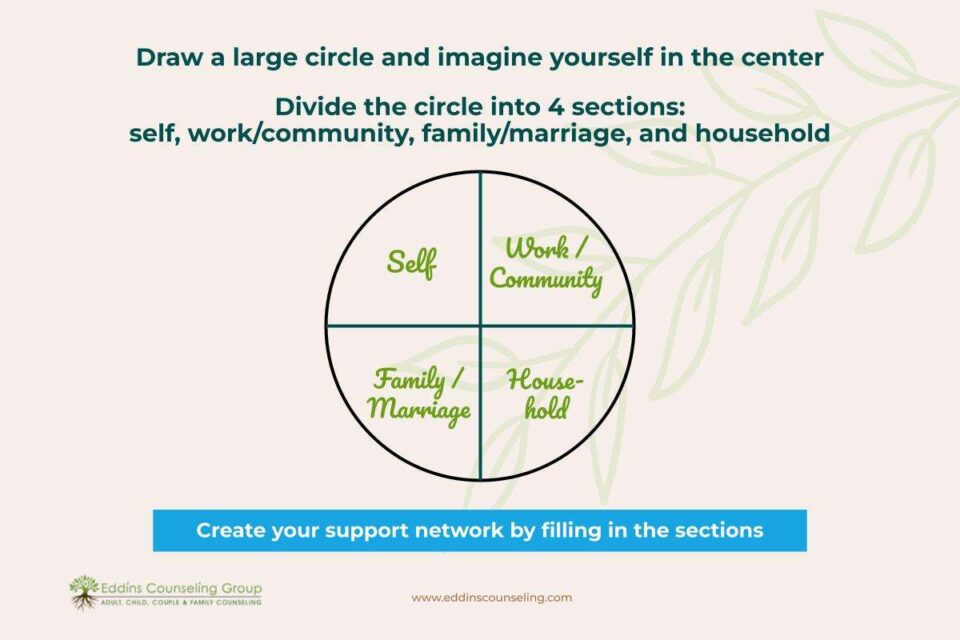
Practice:
- Draw a large circle and imagine yourself in the center.
- Divide the circle into 4 sections: self, work/community, family/marriage, and household.
- Create your support network by filling in the sections.
So if you take a piece of paper and draw a big circle. Imagine yourself in the center.
So now if I divide the circle into four sections, so we have four quadrants. And then each one of you will be one of the categories.
- Self – who do I count on to support me as a person?
- Work and community (might be my boss or it might be a co-worker who is just always there for me to help you)
- Family and marriage – Who is going to be there to support me within my family? (my partner, maybe grandparents, my parents or in-laws)
- Household
See where your support network needs more attention or maybe need to ask some people to your support network. That’s a good exercise if you find yourself feeling alone and like you don’t have enough support in your life.

Values + Priorities
- What is most important to you?
- What drains you and what fuels you?
- Does your calendar align with your values?
We’re going to talk a little bit about values. Values are just what’s most important to you and what do you value?
For some people, it might be honesty, success, achievement, or family.
So what is most important to you? Most of us have several that are really important to us.
But if we can narrow it down to maybe the top 3-5 and then really think about how the way we live our daily life aligns with those values.
This can really help us to feel more connected.
When we’re living out our values, we feel like our lives have a little bit more meaning.
When it comes to priorities, think about what drains you and what fuels you. What are the things that suck the energy out of you? Is it having to spend time with your mother-in-law? (I just said that because it’s the common one) We all know that there are things that after we do them, we just feel completely wiped out.
There are also activities that people us and often those things that fuel up are either self-care or they’re in line with our values. Values and priorities go hand-in-hand.
Practice: Take a few moments to reflect on what you most want your children to remember and know about you.
I have this exercise. So to identify your values, take a few minutes to reflect on what you most want your children to remember and know about you. So let’s say you’re thinking ahead to a time when you’re not here anymore. You have passed on and your children are still here. What do you want them to talk about? What do you want them to remember you for?
Here are some ideas of things to think about:
Mom was very passionate about _____. Some of the things she loved to celebrate in life were _____. Her favorite quote, book, or author (and why) was _____. She always made time for _______. If she had a free day, she’d spend it _______. Her motto or slogan for life was _______. She loved to teach you about ______. She sometimes got tears in her eyes when ______. She got angry when ______. She often volunteered her time to ______. She most admired _____. It was important to your mom for you to know who she really was. I hope this letter helps you understand what an incredible, magnificent person she was, and how much of her will always live in you, too.
Obviously, you’re still here, but by filling in the blanks, we can identify the things that are really important to us. And they may be things that we’ve been neglecting and haven’t really been focused on. But it can really help us to identify what is important to us in life.

Energy + Boundaries
Now we’re going to talk about energy, managing our energy, and setting good boundaries to help us manage our energy.
So a lot of these things are repeated from self-care because when we engage in physical health care by getting enough sleep and eating healthy and making sure we’re getting all of our nutrition, we are also managing our energy.
So we are fueling our bodies to get stuff done.
Manage Your Energy
- Sleep
- Get enough rest for YOUR needs
- Establish consistent sleep and wake times
- Healthy eating and vitamins
- Respect your body’s sensitivities and intolerances
- Supplement to ensure adequate nutrients
- Adequate water
- Exercise / Movement
- Aerobic activity boosts mood and libido
- Limit information overload/stop the doomscrolling!
- Overexposure to media is draining
- Blue light exposure should be limited in the evening as part of good sleep hygiene
- Make time for the things that fuel you
- Connect with your supports
- Meaningful connection boosts feel-good chemicals in our brains
Aerobic activity, for example, boosts both our mood through neurotransmitters and our libido.
So that’s a bonus. When we are constantly bombarded by information, it can be really exhausting. We need to limit the information overload and stop what some people refer to as “doomscrolling”.

When you’re putting on social media and you’re just scrolling mindlessly, but you’re seeing tragedies and bad news and that can really sap our energy.
And even if it’s not like doomscrolling, even if it’s just scrolling or if it’s just sitting in front of the news several times a day, just that overexposure to media can really be draining.
It takes a lot of our energy and attention to really pay attention to that stuff.
You may also have heard of blue light and how it can affect your circadian rhythm. As part of sleep hygiene with my therapy clients, I always talk about trying to limit the exposure to blue light vie electronics, and whatever else in the evenings so that your brain can understand that at night time it’s time to go to sleep.
Another way to manage your energy is to make time for the things that fuel us.
This can be done through:
- our hobbies,
- spending time with people in a support network,
- doing things that really engage our creative side, or
- getting outdoors and being in nature.
To do whatever it is that fuels you and helps you to feel energized and not have your energy drained from you. Make time for those things. Prioritize those things.
Connecting with our support is also very important.
The people that we feel really connected to, that understand us, and the people that it feels good to be around. Being around these people neurotransmitters in our brains. That’s really good for us.
When we’re talking about managing the energy that we have, (because unfortunately, energy is finite and limited and we do not have limitless energy as much as we would love to) it is important so we can really take care of ourselves and feel more balanced and in tune with ourselves and our family.
Boundaries
- Say ‘no’ to things you don’t want so you have the freedom to say ‘yes’ to things you value most
- Healthy boundaries improve relationships, increase productivity, and show respect for self
- Unhealthy boundaries leave room for resentment
A lot of us have difficulty with boundaries. Boundaries can be boundaries around our time, boundaries around what we’re willing to do, boundaries around our emotions, and how much we allow others to affect our emotional state. Boundaries are really important.
This is something that comes up in my individual therapy, and group therapy all the time. Have the freedom to say “No” to the things that you don’t want or don’t want to do. Also, have the freedom to say: “Yes” to those things that you value, the things that are really important to you.
Having healthy boundaries can improve our relationship, and increase our productivity (because we’re not stretched too thin, and we’re trying to do too much at once). It shows that we respect ourselves when we set and maintain healthy boundaries.
When it comes to unhealthy boundaries, on the other hand, we have a lot of room for resentment. This comes up a lot in partner relationships, especially when there are children in the home, because a lot of times as moms, we expect ourselves to just take care of the kids, but also our partners kind of expect us to. And it’s anybody’s fault. It’s just it is how it is.
If we don’t set clear boundaries and really make sure that we are asking for help when we need it and saying “No” when it’s appropriate so that we can do the things that we love to do, then we are a lot less likely to end up resenting our partners or other people in our lives.
Boundaries / Saying ‘NO’
Here are some creative ways to say: “No”:
- Just say No.
- I really appreciate it, but no.
- I wish I could, but no.
- I promised so-and-so I wouldn’t take on too much because I’m working on balance, so no.
- That’s the day of my kid’s game, so no.
- No, I don’t have time, but I know someone who can help.
- I have a prior obligation, so no.
- I can’t do that, but I can do this.
- Let me think about it and get back to you.
So a lot of times when people have a hard time setting boundaries or are not used to setting boundaries is because they want people to like them or they’re people pleasers or they don’t want people to think they are mean or rude.
It’s very often that I sit down and explore with clients ways to set those boundaries, and ways to say “No”.
A lot of times people get into this idea that to say “No”, they have to be very rigid and firm and almost aggressive. I’ll often explore with people different ways to set boundaries that maybe they hadn’t considered before. And so that’s why I wanted to include this information here.

I think one thing that I’ve seen before in numerous places, but also a very dear friend told me one time is that:
“No is a complete sentence”.
It took a little bit of time to sink in for me, as it does for a lot of my clients. Sometimes you can just say “No”, and an explanation of that is necessarily required.
Sometimes when we get caught up in explaining why, it can come across as though we aren’t really sure.
Our “No” is a soft no or we want someone to help us overcome those objections. But really, what we want to say is “No”. If you really just want to say “No”, that’s one way to do it.
You can express appreciation to the person and say: “I really appreciate you inviting me, but no thank you.”
You can express regret: “I wish I could, but I can’t or I don’t want to, or no thank you.”
Some people find it easier to pass the blame to someone else: “I promised my partner that I wouldn’t take on too much because I’m really trying to find some balance between my home life and extracurricular activities or something”.
Just say: “I’m not going to accept that invitation or I’m not going to work on this project with you or whatever it is.”
You can say “No” because you have another obligation, but whether it’s a prior obligation or maybe it’s something that you value, like going to your kid’s soccer practice or something, you can say: “No, because I have been out that day”. “I can’t do that, but I can do this”. If someone asks you to do something to help them with a project.
You can say: “No, I can’t create this presentation for you, but what I can do is I can send over some information that I found really helpful that pertains to your topic”. So saying “No, but I can help you in another way, not the way they need, but in another way”.
Understand that it’s ok to say: “Let me get back to you on that”.
This is because sometimes people can develop this kind of knee-jerk reaction every time someone asked them to do something, whether it’s because they actually really want to or because they feel like they should, or because it’s the nice thing to do. Maybe we said “Yes”, and then when we looked at our calendar for that week and see that we don’t really have the time we thought you did.
So, what I encourage a lot of people to do is to say: “You know what? Let me think about that and I’ll get back to you or I need to check my calendar or I need to check with my partner or I need a little bit of time to figure out if I can fit in and I’ll let you know by Friday.”
So it’s ok to not make a decision right that second when someone asks you something. So I think that’s a really helpful tool for a lot of people.
Practice: Where are you finding it hard to set boundaries and say no?
What if you set boundaries, but then they get disregarded?
Setting the boundaries is not the problem, maintaining the boundary of the problem. It depends on your situation, and so maybe kind of processing that with someone who can help you learn how to say “No” to those things or how to set those boundaries and then maintain them because sometimes it takes just repeating it. Sometimes it takes having some kind of conflict.
Maybe something like a family member consistently assumes that you’re spending Saturdays with them all day.
Or talks about a topic that is on your off-limits list or gives your children food that you don’t want them to have or something like that.
So sometimes it involves saying: “Ok, here’s my boundary. We don’t give my child this and then if they do it, then the consequence might be because I’m not sure if you’re going to follow my ground rules or my boundaries, we can come over for an hour, but we’re not staying all day.”
Maybe if something like that where there’s a consequence or an outcome to being disregarded.
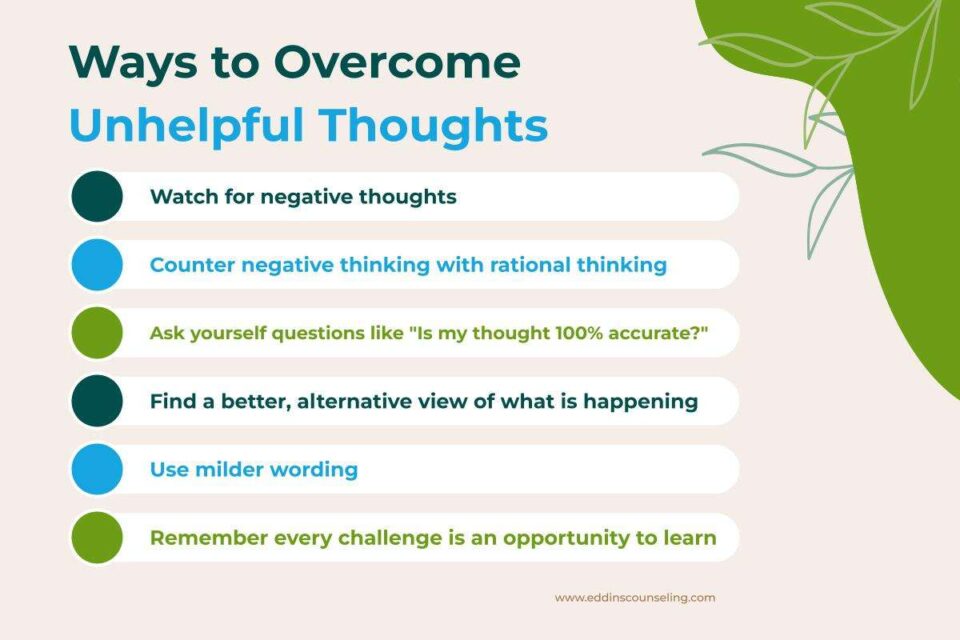
Reframe Unhelpful Thinking
If you have any background in cognitive therapy or know anything about cognitive therapy, we call them cognitive distortions or irrational thinking. A lot of these unhelpful thoughts are from that cognitive therapy world.
So I call them unhelpful thoughts because these are thoughts that are negative. They come up a lot and they are unhelpful in that they do not help us to have healthy relationships with others or ourselves and they do not help us move towards our goals. In fact, they often are barriers to achieving inner peace, but a lot of our other goals too.
Unhelpful Thoughts
- Overgeneralizing
- “I can never get the baby to sleep.”
- “I always mess things up.”
- Jumping to conclusions
- “If the baby doesn’t finish each bottle, she will never grow properly.”
- Catastrophizing
- “My baby spits up after feeding – there must be something wrong!”
- Personalization
- “I must be a terrible mom if I can’t tell why my baby is crying!”
- Emotional reasoning
- “I feel like something is wrong and therefore there must be something wrong”
- All-or-nothing thinking
- “I can’t do anything right and I’m a failure as a mother”
- Comparisons
- “My sister’s son is walking.”
- “She always looks so much more put together than I do.”
- “My daughter’s grades are not as good as her daughter’s grades.”
- Overgeneralizing
So the first one I want to talk about is overgeneralizing. Overgeneralizing is kind of whenever you find yourself saying:
- “I never…”
- “You always…”
- “I don’t do anything right…”
Any time you use one of those absolute words, it’s a pretty good clue that you are overgeneralizing. Here is an example here: “I can never get the baby to sleep”. Well, is that true? I’m sure the baby sleeps at some point.
- Jumping to Conclusions
Another one is jumping to conclusions. So the example here is: ”If the baby doesn’t finish their bottle or the child doesn’t eat dinner every night, or their vegetables, they’re going to get sick. They’re going to be unhealthy for their whole lives or something like that.”
- Catastrophizing
Another one is catastrophizing, and this is when something that to an outside observer would seem very small, but to you, it’s like the end of the world. So, for example, the kids spilled milk on the floor and suddenly it’s like the end of the world.
And now you’re going to be late for work because you have to pick up this mess. So, you are just blowing things out of proportion.
Pretty sure we’ve all experienced that at some point, either from ourselves or someone else.
- Personalization
Then there’s personalization, which is where you take things personally. So if the baby’s crying, that must mean you’re a terrible mom. You think it’s your fault and you’re the problem here.
- Emotional Reasoning
Emotional reasoning is when because we feel something emotionally, we assume that must be true. So because I feel like something’s wrong and that must mean there’s something wrong.
- All-or-Nothing Thinking
Then there’s All-or-nothing thinking this is similar to black-and-white thinking.
This includes: “I can’t do anything right. I’m a complete failure.” It’s like I’m either doing everything right or I’m a terrible person and nothing is right at all or nothing thinking.
You can see how these would be unhelpful because when you start to think that way, you react based on that.
This can cause friction in relationships or cause us to get down on ourselves and not work towards our goals. And so it’s really unhelpful way of thinking.
- Comparisons
Another one is comparison. And this is the one that is not one of those cognitive distortions, but just an unhelpful way of thinking. We might compare ourselves to others, or compare our children and their development.
For example: “My niece is sitting up at five months. Why isn’t my daughter sitting up at six months?” Or we might be comparing something like physical appearance: “She has six kids, but she always has her hair and makeup done. And she looks so cool, calm, and collected.”
We do this a lot on social media because we’re looking at other people’s highlight reels, not seeing what’s happening behind the scenes. So social comparison can be also really unhelpful.
Overcoming Unhelpful Thoughts
- Watch for negative thoughts and try to describe the problem situation as accurately as possible.
- Counter negative thinking with rational thinking.
- Ask yourself:
- Is my thought 100% accurate?
- Is the thought helpful?
- What advice would I give to my best friend in a similar situation?
- What are the chances of this thought coming true?
- What will I think of this problem in a week?
- Are there any other possible thoughts besides this one?
- What will I gain from accepting this thought? What will I lose?
- Find a better alternative view of what is happening.
- Instead of “I can’t,” say, “I don’t” or “I am choosing not to.”
- Instead of “My kid hates me,” say, “My child currently prefers the company of his friends.”
- Use milder wording.
- “I made the best decision I knew how” vs. “That was stupid.”
- Recognize that there are multiple solutions and focus on the positive.
- Remember every challenge is an opportunity to learn.
- Challenge your assumptions.
Let’s talk about a few ways to overcome unhelpful thoughts:
- Watch for negative thoughts
The first one of them is just to kind of watch for them, and notice them. Sometimes you don’t realize that we are having these negative thoughts and that they’re impacting us.
So when we notice them, we try to separate ourselves from the side and describe the situation as objectively and as accurately as possible.
This helps us to kind of look at our thoughts like we are scientists and then we won’t get caught in the emotion of it.
We’ll be looking at it more objectively and rationally.
- Counter negative thinking with rational thinking
So if the negative thought is: “There’s something wrong with my child because they always ask for help with dinner”.
Maybe countering that there’s something wrong with your child. The part where they ask for help may be objectively true, but the part there’s something wrong. That’s the part that’s the negative and maybe irrational thought.
Another example can be: “There must be something wrong with me because I’m feeling a lot of emotion and I’m crying a lot.“
Well, maybe it’s not that there’s something wrong with you. Maybe it’s just that you have a lot of feelings that you need to express in a healthy way.
Questions to Ask Yourself:
- Is my thought 100% accurate?
- Is the thought helpful?
- What advice would I give to my best friend in a similar situation?
- What are the chances of this thought coming true?
- What will I think of this problem in a week?
- Are there any other possible thoughts besides this one?
- What will I gain from accepting this thought? What will I lose?
These questions are some of the most useful ways to challenge unhelpful thoughts. If you have a negative thought that pops up, ask yourself these questions and look at it like it’s a science experiment.
What is the evidence that suggests this thought is true and what is the evidence that suggests this might not be true?
How would I talk to a friend who was in a similar situation?
And if it’s more like fortunetelling, what are the chances of this coming true?
What will I think about this in a week?
It’s about putting things into perspective. These questions are really helpful to challenge those negative automatic thoughts that we can have.
- Find a better alternative view of what is happening
Is this the only way to look at a situation or is there a possible alternative way to look at it, from another angle? Think about it from a different perspective. For example, instead of saying: “I can’t set boundaries or I can’t make a decision”, reframe that and say: “I won’t make a decision or I’m choosing not to make a decision”.
That can be kind of empowering and it can reframe so that it’s no longer a negative thought or a defeatist kind of thought. Now it’s something that is malleable and you can work with.
- Use milder wording
Using milder wording, so instead of saying: “That was a stupid choice”, you can say: “You know what, I could have made a different decision, but I made the best decision I knew how at that time, given the information or resources I have available to me. So just reframing to make something less harsh and be kinder to yourself.
- Remember every challenge is an opportunity to learn
Look at challenges and opportunities to learn. So it’s not the end of the world or an insurmountable challenge. This is something and an opportunity for you to learn something new, develop different new skills, and then really challenge your assumptions and your perspective.
Practice: Reframe these unhelpful thoughts:
- “I’m a bad mother.”
- “I never do anything right.”
- “I should be further along by now.”
Here is a small practice to reframe these unhelpful thoughts. For example, the unhelpful thought: “I never do anything right”. How would you reframe this?
So instead of saying “I never do anything right”, say “I didn’t do this right. This was a bad day. I maybe I made a mistake, but there are things that I do right”. If it’s helpful, you can give yourself some examples of those things that you do right.
Be Present
The last thing I wanted to talk about today was being present. Being present means being here now. So, I’m going to be here in my body, in the physical space that I’m inhabiting, and I’m going to be aware of everything that is happening around me or within me or both.
Being present is associated with:
- Increased happiness
- Better protection against stress
- Increased capacity to deal with life
- Enhanced immunity
- Positive changes in the brain
That skill of being present means being able to ground in the center and here is associated with more happiness. You are also more resilient, so better protection against stress. You have a better capacity to deal with the challenges that life throws at us.
As parents, we know that that happens constantly. It can even improve your immunity. Research has shown that it can boost your physical health and it causes positive changes in your brain.
Some ways to be present:
- Yoga
- Studio, website or YouTube, apps like Yoga Studio
- Meditation
- Apps like Headspace and Calm
- Guided meditation
- Body scan
- Grounding exercises
- 5 Senses Grounding
- Grounding kit
- Any of the senses
Yoga
I always recommend yoga. At some point maybe will actually do yoga in sessions, but I don’t at this point. I’m not a professional practitioner, but yoga is really helpful to really get in touch with your mind so you can go to a yoga studio, or do yoga outdoors.
You can practice yoga with a group or with an instructor. Also, you can look at yoga videos on YouTube, your favorite website, or use an app. I discovered one recently called Yoga Studio, which walks you through different yoga poses and routines. Yoga is a great way to practice the skill of being present.
Meditation
Meditation is another way to be present. Mindfulness meditation specifically is really helpful to teach you the skill of being present. I know a lot of people really like apps like Headspace and Calm. I think there are so many apps out there for meditation.
What I really like about apps is that an app can remind you. You can set up your push notifications and then you can click on the application and go directly there. But you could just as easily set aside time every day, mark it in your calendar and find a guided meditation or a body scan, or just be quiet and still and do a meditation on your own.
Grounding exercises
Grounding exercises are also really helpful, and the good thing about them is that you can do them anytime, anywhere. You might be in the midst of chaos in your home, like your kids might be ordering you around and you might start to feel a little bit stressed and your thoughts might start talking to you in unkind ways or you might start thinking about all the things that you need to get done and how stressed out you are.
A grounding exercise is a great way to bring all that in and say: “Ok, I’m only going to be here now.” and then respond from a place of being present. When we’re present and we’re grounded, we’re able to respond to what’s in front of us as opposed to all of the thoughts that can spin out of control pretty quickly.
All those expectations and negative beliefs and unhelpful thoughts that get in the way of responding calmly and assertively and effectively to the situations and people in our environment.
Grounding Exercises
One of the most common grounding exercises that I teach clients (especially those who have a lot of anxiety or panic) is the Five Senses Grounding Strategy.
You can have like a grounding kit or grounding box where you put different things that engage your senses. So it might be a candy that has a really distinctive flavor or it might be something that you can touch that has that tactile stimulation. It might be a little vial of essential oil that you smell.
So you can create a grounding box if grounding is something that you use often or that you need to call upon often. You can create a grounding box that you can then go and get and use the things in it to really just kind of ground yourself in. But really, you can use any of the sensors to ground.
The grounding is just anything that you do that takes out of your mind and out of all of the unrest in your brain and brings you back into the present so that you can be here in the present.
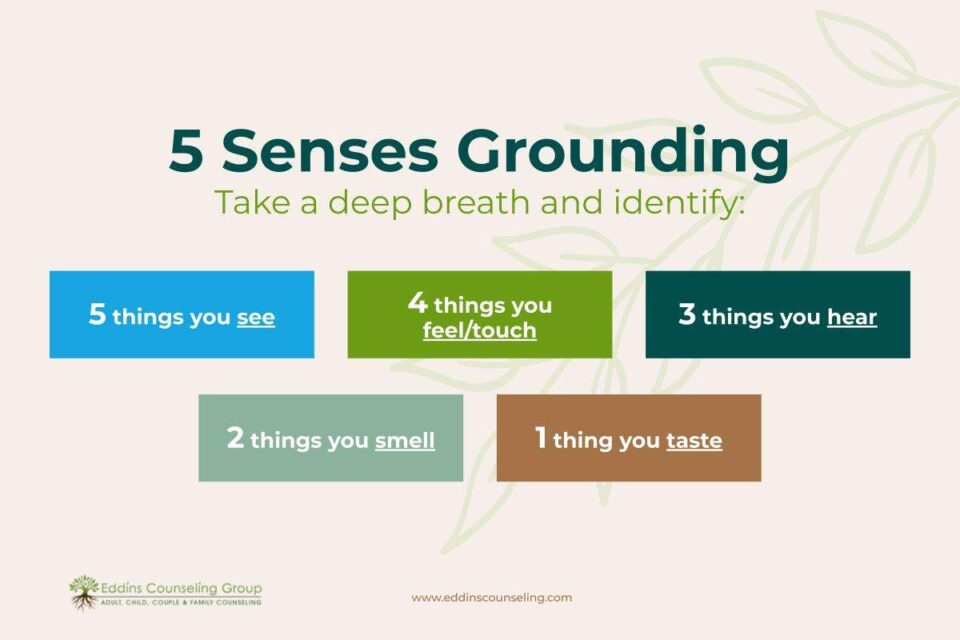
Practice: 5 Senses Grounding
Take a deep breath and identify:
- 5 things you see
- 4 things you feel/touch
- 3 things you hear
- 2 things you smell
- 1 thing you taste
The Five Senses grounding strategy is pretty simple. Sometimes it can be hard to remember the different things to do, but the awesome part is it doesn’t matter. It really doesn’t matter because the goal is to just get you out of your head and into the present environment and in your body.
-
5 things you see
So to do this, you’re going to take a deep breath and identify five things that you can see. For example, I’m going to tell you five things that I see: my screen, a lamp, a tissue box, a picture on the wall, and my pen. Those are the five things I see.
-
4 things you feel/touch
Next, you’re going to identify four things that you can feel and that means your tactile sense. So, for example, I can touch the computer in front of me, I can feel the way that my shirt is resting on my collarbone, I can feel the chair underneath me and I can feel where my feet are touching the bottom of my shoer.
-
3 things you hear
Then, three things that you can hear. I hear the white noise machine next to me. I can also hear some traffic outside. If I’m really quiet, I could probably hear myself breathing and talking.
-
2 things you smell
Next, two things that you can smell. And so it may be the smell in your environment or maybe two things that you can pick up and smell. For example, my fabric softener or the hand sanitizer I use.
-
1 thing you taste
And, last, one thing that you can taste. I can taste a little bit of the water that I was drinking.
Once you do that, you are not thinking about the things that were worrying you or bothering you or the negative thoughts. You’re thinking about what you were sensing. You’re thinking about your environment. And you’re thinking about your body and what you feel. So that’s why it’s a great way to get grounded and be present.
Practice: Box Breathing
Another strategy that I really like that helps with relaxation but is also good for grounding because it gets you back into your body is box breathing. So it’s called box breathing because you’re going to do equal counts for the in-breaths and then holding and then the out-breaths and then holding. So if you think about it, it forms a square.
Get comfortable, sit up straight or relax in your chair and then just breathe in for five seconds. Then you hold it for 5 seconds. Then you breathe out for 5 seconds. And then you hold that for another 5 seconds. And then you keep going.
So you just imagine that it’s a box. It doesn’t have to be 5 seconds. I just randomly chose that number. Do whatever is comfortable for you. It might be 3, it might be 10 but just do the equal count.
Once again, you’re focused on your breath, on the activity, and just the sensations associated with breathing. It is also relaxing because breathing of any kind induces a relaxation response. So that’s another way to really be present.
Practice: Draw a card from the Mindful Reminders Card Deck
I learned about the Mindful Reminders Card Deck when I attended mindfulness-based therapy. One of the card decks is for teens and adults. There are 52 cards and on each card is written a mindful exercise.
Here’s an example of one or two of these so you can see what they’re like:
- Relax your muscles from your feet up to your face. Notice how your body and mind feel before, during, and after.
- Put down this card and walk to wherever you were going or do whatever you were about to do. Notice every sensation for each of the next 10 steps.
They’re just ways to be mindful. There’re 52, so you could pick one each week and practice the same one for a week or you can use it however you like.
There is also a version that’s more for children. It’s called Growing Mindful: Mindfulness Practices for All Ages. They’re more geared toward kids. For example:
- Place one hand palm up in your other hand, then place both over your heart. Close your eyes, and notice the sensation and the emotion as you take three breaths.
There are lots of different ways to be mindful, grounded, and be present. And so there are different resources that you can use. Let’s say you were at home and feeling a little bit stressed out or anxious, you could go and just randomly select a card and do what it says. It doesn’t take any thinking. It doesn’t take any planning.
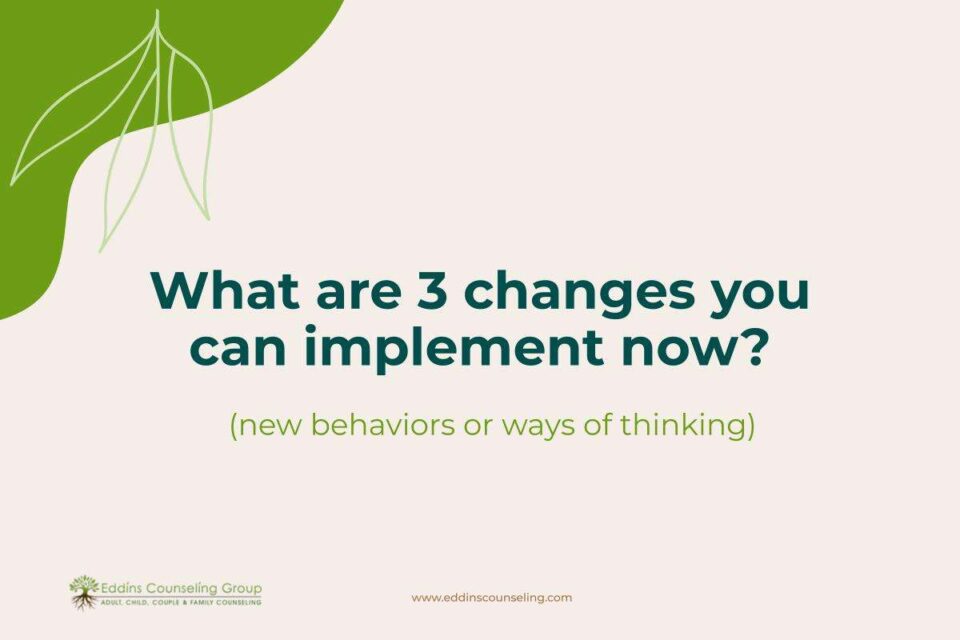
A Challenge For You
“Homework”
- Identify 3 changes you can implement now (new behaviors or ways of thinking).
- Create space in your schedule for these 3 changes.
- Tell a trusted friend or other support.
I want to present you all with a challenge. That challenge is to identify three changes that you can implement now based on what we’ve talked about. And then create space in your schedule for those changes and tell somebody to get a little bit of accountability for that.
What three changes do you want to implement? For example, exercise daily, eat better and love yourself more. So, focusing on that physical health care, managing your energy, and combating unhelpful thinking.
I think it’s really important to commit to doing the things that we know help us to feel more centered so that we can be more in tune with ourselves and have healthier relationships and raise healthy children. That’s the goal for a lot of us.
Another example of three commitments could be exercise, meditation, and drinking more water. Super important to fuel our bodies and our minds and our hearts.
On our website, there is an article/ blog post about grounding exercises that I send to my clients a lot because it’s very thorough. I think it’s probably the best resource that I have found for grounding exercises to date.
I encourage you to put what we talked about today and to practice yourself more kindly and patiently.
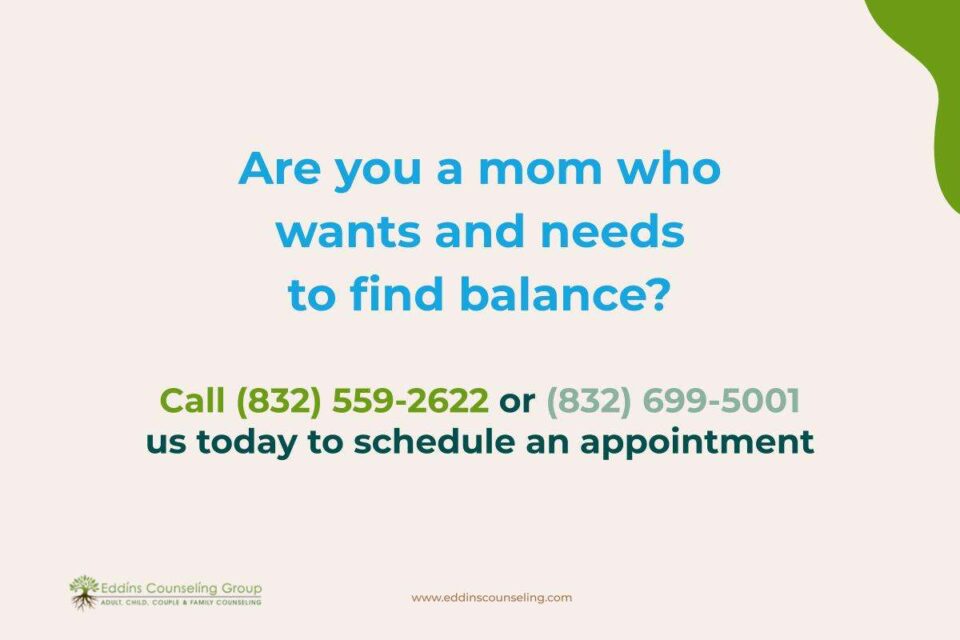
Be more prepared for your family if you need any ongoing support. We have a group and individual therapy here. My specialty is moms, but there are some other people in our practice who also work with moms. You can visit our website or you can give us a call.
I will be starting a Moms group here in the next couple of weeks. So I invite you to reach out to us about that if that’s something you’re interested in. We can do some group therapy and support groups.
This has been great, I’ve been so excited to share this information with you all. Thank you all for interacting in the chat and for the different exercises and practices that we have. If you have any questions or need any additional support, please feel free to reach out to me.
You can access my information on our website or you can contact our administrative staff as well. You will receive, if you have not already, the feedback form by email as well. And I believe there’s also some additional information that would come directly from the practice otherwise.
Thank you all so very much for your participation. I really enjoyed that. And I hope you all have an enjoyable rest of the evening and take wonderful care of yourselves.

